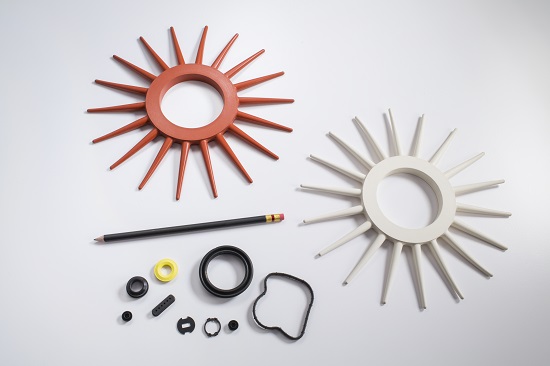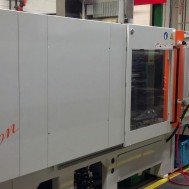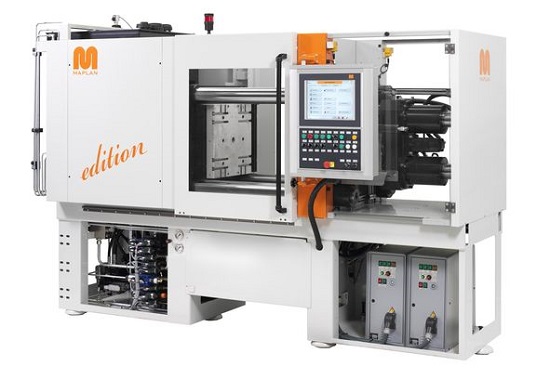Using the injection molding process to create rubber parts is a complex task. How will rubber enter, fill and cool the cavity? How can stress be minimized? How will the final part be used?
Adhering to some basic rules of rubber injection molding will result in parts that are easy to manufacture and final applications that are successful — and understanding these rules is your first step to become a rubber injection molding expert.
Understand The Process
Injection molding — a more complicated process than compression or transfer molding — is utilized for a variety of applications. It can be used to produce very small parts to entire automobile body panels.
During the rubber injection molding process, uncured rubber is extracted into the machine using a screw feeder system. The screw feeder takes in the exact amount (or shot size) of material needed to create the desired number of parts.
Rubber is fed from a hopper into a heated barrel, and the material is slowly pushed by a screw-type plunger into a heated chamber. Material is then preheated to a state that will allow material to flow through a gate and runner system to fill the desired cavities evenly. The mold remains at a set temperature so it can solidify once it is filled. When material has reached a cured state, the mold will open and parts can be removed manually or using a brush system to strip them off of the mold.

Why Rubber Injection Molding?
- Rubber injection molding produces parts with quicker cycle times than compression or transfer molding.
- The secondary need for preforms to make complete parts is eliminated. This is usually a labor-intensive step that can potentially affect the finished product through varying pre-form weights and shapes.
- Rubber injection molding gives the ability to make custom shapes with little flash or rubber waste.
- Improved versatility in durometer shores, which can run from Shore A 90 to Shore A 40.
- Material is preheated before it is forced into cavities. This decreases the viscosity of the material, allowing it to flow more easily into the cavities.
Things to Keep in Mind
Although the process may have several benefits, there are some downsides to keep in mind. Rubber injection molding may have higher initial startup costs when compared to other molding processes. Tool modification can also be difficult with the machine’s runner system. Material is also limited to high-flowing compounds when it comes to rubber injection molding.
Common issues with rubber injection molding
Since rubber injection molding is a complex technology, the process can present production problems caused by defects in the molds or part processing.
Here’s what to look out for:
- Flash. Flash refers to the extra thin-layered material that exceeds the normal part geometry. This can be caused by tool damage, too much injection speed or a low clamping force.
- Short shot (or non-fill). Due to variations in raw material, short shots or a partial part can happen in the final product. To avoid this, be sure there is enough material, proper injection speeds and high enough pressure to fill the entire part.
- Foreign particles. These can include burnt material or extra material embedded in the part. Beware of particles on the tool surface, foreign debris in the barrel or too much heat burning the material prior to injection.
- Warping. Parts can sometimes twist or distort during the process. This can happen when cooling time is too short, material is too hot or incorrect temperatures are set.
- Voids. Sometimes you may find empty spaces or air pockets within molds. To avoid this, be sure that enough pressure is held to pack out the part during holding time. Also, be sure that part walls are the same thickness around.
Machinery: Maplan FIFO Rubber Injection Press
Injection molding machines, or presses, consist of a material hopper, an injection ram or screw-type plunger and a heating unit. Molds are clamped to the platen of the molding machine, where material is injected into the mold. The total clamp force needed is determined by the projected area of the custom molded part.
Apple Rubber uses Maplan FIFO rubber injection machines that have the capabilities to run in fully automatic modes with shot sizes from 130 cm³ up to 8,600 cm³. The Maplan machine has a Cool Drive II energy-saving servo-hydraulic system, customized brushing and ejection systems for maximum efficiency, and a PC5000 touch control screen to improve the injection process. The units allow workers greater control over the speed and efficiency of the production process.
Our achieved quality levels consist of:
- Rubber Injection Molding Rubber Manufacturers Association, RMA-A1
- RMA Class A O-Ring tolerances or better
- ISO 3601-1A O-Ring tolerances
- ISO 3601-3 Grade N and Grade S tolerances
We want to hear from you!
How has rubber injection molding changed your manufacturing process? What kinds of obstacles do you face in your day-to-day schedule? We’d love to hear from you. Learn more about our mold-making capabilities, contact our experts or connect with us on Twitter @AppleRubber.

